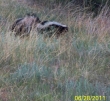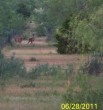What is it best called, frog hunting, gigging, grabbing or shooting? I’ll choose just plain froggin’. It is the most different of all the hunting/fishing sports. Thinking about it, I have never gone frog fishing, as such, but once I caught a bull frog on a small, frog colored popper and was rewarded with quite a battle on a fly rod. With Buck, one time, I saw him catch a bull frog on his jigger pole.
Most of the time froggin’ is a nocturnal sport and a must, for success, is a good strong, spotlight. I guess that when the light is shined in a frog’s eyes it mesmerizes, hypnotizes or paralyzes them.
My start at froggin’ was in a group of stock tanks on my Uncle Shelton Gafford’s ranch in Falls County, Texas. We would take a light, along with a .22 rifle and walk slowly around the bank of the tank and when a frog was spotted, Pow, dead frog. Shooting .22 shorts into the banks was safe, but we constantly had to be on the lookout for cotton mouth water moccasins. This was a good way to work the tanks, but about a third to one half of our frogs, when shot, would reflexively jump into the water and sink. On a larger lake, this method is not encouraged.
Later, my son, Randy, went a step farther with his shooting of frogs. He found a honey hole for frogs on our deer lease in McCulloch County, Texas. He would sneak along the bank, spy a frog, and shoot. He shot five in a row, but each, reflexively, jumped into the water and sank. Randy is a former student at Texas A&M and correctly figured that if he waded out, arm pit deep into the tank, and shot the frogs from the water, the impact of the bullet would push the frogs back up on the bank. His surmise was correct and we had a frog leg feast (after he dried off) that night.
Gigging is the best way to capture frogs on larger bodies of water. A gig is a simple tool, a four foot, or longer, pole with a sharp instrument attached. It helps if the instrument also has a barb on it. If you know the bottom, and the lake is free of gators, wading is a fine method to use to sneak up on them, otherwise, a boat, or skiff, is required. Just shine the light in their eyes, sneak up quietly and stick ‘em with the gig and into the toe sack with them.
The most exciting method of capturing a bull frog is grabbing them with your bare hands. It is a lot like gigging, but without a gig. One thing, for sure, you really check out the bank closely before you grab one. Shine their eyes, sneak up on them, a boat is best, check the surroundings for snakes, then quickly grab the frog, whack its head and into the toe sack with it.
The most unusual capture of frogs that I ever encountered was after O.H Buck and I were returning, on a Farm to Market Road, from a successful froggin’ trip to a private lake, when it began to rain. Rice fields and their canals were on both sides of the road, when we noticed, what looked like cow paddies, in the road. Stopping, we saw that it was bull frogs instead and quickly getting our lights and toe sacks, added another dozen frogs to our “catch”. I still can’t say what the frogs were doing just sitting on the road in the rain?
The best part of froggin’ is the eating. Just skin the legs, cut them off of the Frog, wash them, dip them in corn meal and fry. Smaller legs are very good grilled and my favorite, are legs cooked in a butter, jalapeno, garlic and lemon/lime sauce – Frog Legs Jon.
But caution! Watch out for snakes! One night we were easing along the dam of a rice field reservoir, when from out of a tree, dropped, “plop”, a four foot cotton mouth, right into the boat. We both vacated the premises quickly and dispatched the snake with our gig. But that ended our night’s froggin’.













 the camera shutter wasn’t fast enough to stop it.
the camera shutter wasn’t fast enough to stop it.